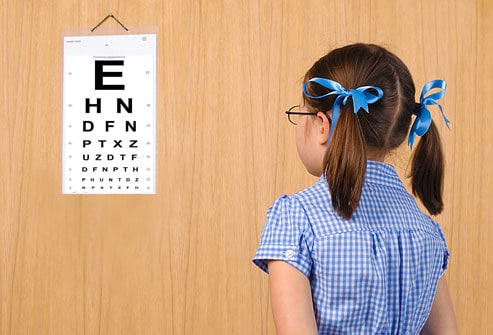What should I do?
The average increase in myopia for those who are progressing is about 0.37 diopters/year. That means an 8 year old child with low myopia most likely won’t be able to read the big “E” on the eye chart without glasses by the time they are 13! Low levels of myopia and the opportunity they afford for more effective treatment are often missed quickly as the change is usually most rapid in the first year or two. There are advantages at any level but there is no advantage in waiting.
HAVE YOUR EYES EXAMINED
You need an eye exam. You need an eye exam at an age before you can even read this web site. Research is showing that specific findings during an eye exam identify those who are most helped by treatment. Eye exams are also useful because blurred vision does not mean you have myopia. There are many other reasons for blurred vision that require treatment. People with clear vision also can have significant eye problems. Don’t try to guess what you have. Find out.
SPEND TIME OUTDOORS
Children should strive to be outdoors at least two hours a day. We do not know if this is the critical amount of time, but children who were outdoors at least that long did not progress in their myopia as quickly. Participation in sports or other strenuous activities is not the requirement as indoor sports such as basketball do not give the same protection. Studies indicate that the activity might best be focused on distant objects, such as when bike riding, as opposed to near activities like playing cards. Just play outside instead of watching TV or computer screens.
How is the idea of “outdoor time” used for myopia control?
One of the big surprises of recent research is the importance of how increased time spent outdoors helps in preventing myopia. At the present time it appears that 14 hours a week or more outdoors are significantly effective in reducing myopia progression.
How does increased outdoor time work for myopia control?
We don’t know. There are many possibilities and studies are under way to help determine what is happening.
What might be gained by outdoor activity?
- Sun exposure with Vitamin D production (Vitamin D is produced by the skin with the aid of sunlight.)
- Exposure to bright light releases chemicals in the retina such as dopamine that can control growth
- Exposure to visual opportunities for far distance vision
- Exposure to beneficial microorganisms
- Unknown events that may be caused by being outdoors or that often happen to people who spend time outdoors.
- We do know that it is not sports or physical activity. The benefit happens for children playing outdoors with no organized sport activity.
“Outdoor activity” presents a complicated, broad area of research. An example of unexpected findings about outdoor activity is that exposure to the common soil bacterium Mycobacterium vaccae is believed to have anti-depressant qualities and has been shown to increase learning behaviour. It increased serotonin levels in the brain. Serotonin is part of the signalling system within the retina controlling eye growth. While no one has studied the possible connections to myopia control, the results indicate the complexity of trying to find exactly what outdoor time does to control myopia.
The outdoor benefit is not due to children outdoors reading less. Outdoor children do better regardless of their indoor reading activity. This means that it is not the “bookworm”, the child who reads a lot, who is more likely to become nearsighted. It is the child who doesn’t go outside, whether they are a reader or not.
Are there any side effects?
Perhaps the greatest risk is premature aging of the skin and skin cancer due to increased exposure to UV light from the sun. Sunscreen lotions may prevent sunburn but do not protect well against skin cancers. Sunlight can also increase the risk of cataracts. Due to these factors, many people wear sunscreen on their skin and sunglasses on their eyes. Whether these actions negate or reduce the beneficial effect of being outdoors is not known.
Obviously protecting your child is important. As stated above we would expect sensible protection from the sun with outdoor activity. Sunglasses are a very important part of this protection.
THE IMPORTANCE OF WEARING SUNGLASSES
Most people understand the link between UV radiation and skin cancer but many of us do not know about the damage caused by UV to the eye.
It has been reported for years that UV, the harmful part of natural daylight, damages the eye. They have been attributed to causing cataracts, Age Related Macula Degeneration and damage to the cornea.
This all can be prevented by the use of sunglasses, a wide range of sunglasses can be seen here:
UV Radiation Protection
It is not yet known how much exposure to UV radiation will cause how much damage, but a good recommendation is to wear quality sunglasses that offer good protection when working outdoors, participating in outdoor sports, taking a walk, running errands or doing anything in the sun.
- To provide protection for your eyes, your sunglasses should:
- Block out 99-100% of both UV-A and UV-B radiation.
- Screen out 70-90% of visible light.
- Be free of distortion and imperfections.
If you spend a lot of time in bright sunlight, wrap-around frames can provide additional protection from harmful UV radiation by keeping UV rays from reaching the eyes. Also, remember UV eye protection for children and teenagers. They typically spend more time in the sun than adults.
Finally, even if you are wearing contact lenses that have UV protection, you still need to wear sunglasses. UV rays will likely affect the eye tissue that is not covered by the contacts. Your eyes will be more comfortable, too, with most of the bright light blocked..

